Abstract
The objective of this paper is to explore the dynamic factors of the work–family interface (WFI) of construction professionals in South India. It also aims to develop a model of the factors that influence the WFI. This study identified seven factors from the literature: work environment, family, stress, personal satisfaction, work culture, top-level acceptance, and work–family balance. Data were collected using questionnaires distributed among the construction professionals in South India. Data analysis was performed using SPSS. The mean standard deviation and shape measures (skewness and kurtosis) revealed that personal satisfaction (3.55) was rated the top factor for WFI, followed by work–family balance (3.15), stress (2.91), and work culture (2.83). The study found that the work culture was not significantly correlated with work environment, family, stress, personal satisfaction, or top-level acceptance. The developed SEM model emphasises the need to pay keen attention to the work environment and the work–family balance among the construction professionals in India. Management should consider these factors to design standard policies to improve the WFI and design work–life balance strategies to create stability in the lives of construction professionals. The current research is limited to only two cities in Kerala and Tamil Nadu in South India. More studies must be carried out for more states in India to better understand the current situation of WFI as there is limited evidence of studies on the WFI of construction professionals in India. Therefore, the findings of this study fill the existing knowledge gap and provide a clear insight into improving the mental and social well-being of construction professionals in the Indian construction industry and construction professionals in other developing countries.
1. Introduction
The Indian construction industry is vast and is the second largest sector contributing to the national GDP. The industry employs many people, however, it is highly fragmented and diversified in nature. As it is a challenging and complex sector requiring a high amount of investment, the productivity of human resources is a key concern [1]. Lingard et al. [2] observed that low productivity is prevalent within the construction industry and it contributes to the low level of work–life balance (WLB) among professionals in this sector. A low level of WLB has adverse effects on individuals, families, and the workplace. According to Townsend et al. [3], stress in the family and workplace negatively impacts family life, sleep dysfunction, and workplace health and safety risks. Given this, Lingard and Francis [4] and Townsend et al. [3] have suggested that organisations should support their workforce to reduce emotional exhaustion by improving the WLB practices. However, in the management of construction projects, much attention seems to be paid to the arrangements of contracts, legal issues, the adaptation of technology, and the milestones, with little consideration of the emotional and physiological well-being of the employees [5,6]. It is concerning that the construction industry has been characterised by long working hours and overtime, which contributes to stress. In the specific context of developing countries, the construction sectors face many challenges and has low productivity. Studies have identified several factors that contribute to productivity, including human factors, personal factors, work-supporting factors, motivation, change in lifestyle and job satisfaction [7,8,9,10,11,12]. The improvement of individual performance can be achieved by understanding human nature and the structural nature and indeterminateness of organisations. Top-level management should aim to manage emotions and reduce pressure based on the understanding that employee turnover and productivity are determined by organisational commitment. This will also be reflected in the retention rate of employees in the construction organisation [13,14,15].
Researchers worldwide are trying to understand WLB in the construction profession, including Australia, UK, Poland, South Africa and US. However, in India, very few studies have attempted to familiarise the various factors that influence the WLB of construction professionals [5,6]. The current study aims to fill this gap and direct future research into the work–family interface (WFI) of construction professionals in India and other parts of the world. This study’s objectives are to identify the predominant factors that influence the WFI of construction professionals in South India. In addition, to identify the association between the WFI factors the independent sample t-test, correlation analysis, and confirmatory factor analysis (CFA) were used.
1.1. Work–Life Balance (WLB) and Work–Family Interface (WFI)
Every employee should know what they do, that is, ‘live to work’ or ‘work to live’. In the construction industry, there is no defined work time, and work personnel must be available at any time for work. WLB refers to the equilibrium between work-related activities and personal life responsibilities. It involves effectively managing and integrating work and non-work domains to reduce conflict and enhance well-being. WLB aims to create harmony and satisfaction in both work and personal life. Work–family interface (WFI) refers to the interaction and interplay between an individual’s work life and family life. The amount of WFI states the degree of segmentation versus integration among work and family spheres. The quality of WFI refers to negative versus positive interactions between work and family domains and examines how work-related demands and family-related demands can influence each other, leading to various outcomes, such as conflict, enrichment, or segmentation. A positive WLB, where people are able to effectively manage their demands in work and personal life, can contribute to a positive WFI. When individuals have a good WLB, they are better able to meet the demands of both their work and family roles, thereby reducing conflict and improving the compatibility between the two domains. On the other hand, a poor WLB, characterised by excessive work demands, long working hours, and neglect of personal life, can result in a negative WFI. It can lead to work–family conflict (WFC), where the demands and pressures from work interfere with family responsibilities, causing stress and strain in both domains [2]. Every employee works to provide financial support for their family, but when he or she cannot spare personal time for their own family, the WFC arises. WFC also has an unfavourable consequence on work satisfaction, organisational commitment, productivity, etc. On an individual level, it is related to employee burnout and mental health issues. Career development includes the ability to focus on personal and professional values, the appropriate attribution of responsibilities, ethics, roles, knowledge, and mature decision-making; all these aspects must be developed through education at the beginning of the training level so that conflict can be reduced [16]. Work-related pressure and stress will be reflected in the personal lives of the individuals, thus negatively impacting the family life of construction professionals. Most professionals working in the construction industry are exposed to WFC. Therefore, WLB becomes an essential issue in the construction industry in terms of both organisational effectiveness and occupational health. The WFI can be described in terms of amount, quality and context. The context of WFI refers to the perspective from which the WFI is studied. The working environment should be positive and comfortable enough to allow deadlines and goals to be met. Many sub-factors, such as working hours, nature of work, etc., also make it complicated. Stress is also a significant factor, including stress from work, family, and health problems. Additionally, family support is essential to make a person perfect at work. Top-level acceptance is another essential factor. The culture of work of an employee and their co-workers too is a crucial factor affecting the WFI [2].
Lingard and Francis [17] showed a disproportional link between work and family life in the construction industry, providing a significant contribution to the research on WFI, particularly in the construction sector. The factors that they focused on were individualistic, gender, the phase of life, and degree of job or family focus. In summary, WLB and WFI are closely linked. A good WLB can positively influence WFI by reducing conflict and improving the compatibility between work and family domains. In contrast, a poor WLB can lead to WFC and negative outcomes in both work and family life.
Employers should provide a healthy WLB for all employees, as this will enhance the work culture. In Western countries, there is ample evidence of WLB practices; when it comes to developing countries, the implementation of such practices is still in the early stages. Therefore, there is no evidence in the literature for WLB practices in developing countries in the construction industry, which adds significance to the present study [18]. Job satisfaction involves considering various probable work, personal, and cultural incentives or motivations. The nature of the job, the designation of the job, the income rate and the work environment have all been considered; the three elements that they evaluated for WLB were balance of time, participation and satisfaction relevant to work and family [19]. WLB has also been correlated with quality of life, but is limited to assertive conditions [20]. Regarding job satisfaction, self-respect, a fair approach, professional treatment by co-workers, and understanding the human values of employees are all key factors. Specifically, all of this can lead to better job fit while promoting WLB in the construction industry. In particular, women have the strongest influence on this strategy, despite the fact that the construction industry is largely a male-dominated industry. There has been an increasing acceptance of the fact that a healthy WLB can benefit organisations. However, several factors within an organisation must be considered before implementing WLB practises. Management support, employee effectiveness, intentional and behavioural outcomes, work environment, organisational culture, and acceptance by top-level management must all be considered integral to promoting work–family support [21,22].
1.2. Factors Influencing the Work–Family Interface (WFI)
The work environment, stress, and work culture all are interlinked. The work environment comprises the physical and non-physical factors prevailing in that environment. It includes geographic location, technology, communication systems, physical setup of the building, transportation systems, infrastructure, relationships (internal and external), and the work climate. It has a significant impact on the WFI. Recent studies have stated that stress plays an essential role in human behaviour, both mentally and physically [9,23]. As such, mental and physical illnesses caused at work unequivocally affect conflicts in the family.
Hofstede [24] explained that work culture is similar to work climate. Work culture also has several factors: power distance, individualism-collectivism, uncertainty avoidance, masculinity–femininity, and assertiveness. All these factors show mixed results [24]. The influence of family on the WFI generates temporal effects carried out from the family to the workplace. The three main ways in which the family can impact the WFC are balancing time, participation and satisfaction, which means dedicating time equally, participating and satisfying both the organisation and the family [25,26,27].
Employee satisfaction is a critical factor that impacts their success as a worker, dramatically benefiting the company. Therefore, employee satisfaction is an important driving force for organisations [28]. WFC occurs when there is a demand for targets assigned in work that makes it difficult to fulfil the desires of family life. WFC have been derived in terms of the inter-role conflict wherein role pressures from work and family territory are reciprocally conflicting in some respects, e.g., support in the work role is made more difficult by involvement in the family role. There are three main types of conflict: time-based, strain-based, and behaviour-based. Improper WLB leads to poor WFI [4]. Acceptance, depending on the situation, can change its role. Acceptance may or might not influence the WFI. The study identified seven WFI factors affecting the construction industry from the literature, which are shown in Figure 1.
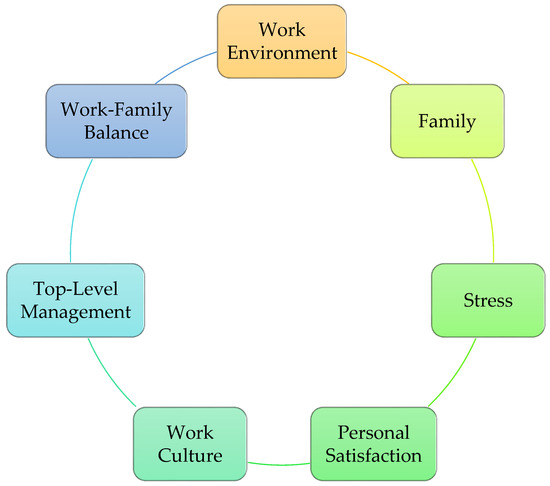
Figure 1.
Work–family interface factors.
1.3. Impact of the Work–Family Interface (WFI)
The impact of the WFI has both positive and negative possible outcomes: A good work environment has a positive effect in that it increases productivity, organisational commitment and loyalty, and corporate citizenship, which in turn helps the individual to be motivated, recognise their skill, and gain satisfaction from their well-being. Stress unequivocally has negative impacts on the individual’s health. The outcomes of the work culture have shown mixed results: positive (increased commitment); and negative (degradation of mental and physical status and health). However, employees with better personal satisfaction have reported better psychological well-being due to having more control over their family time and thus having more time to spend with their family. A healthy WLB includes the appreciation of expressiveness and emotional sensitivity. Additionally, employees must not take the work burden home to the family. Finally, top-level acceptance (of the need for a healthy WLB for employees), when effectively transmitted throughout the organisation, helps improve employee retention at work, which is positively reflected in an improved WFI [29].
Research in the construction industry has revealed a high level of stress due to higher job demands and long and irregular working hours, leading to burnout of employees [30,31]. The WFI is associated both negatively and positively with the family domain as well the work domain. When it comes to the Indian construction industry, depending on the role, levels of stress vary. Physiological, physiological, and sociological factors significantly affect professionals in India [30,31,32]. If the employee is satisfied with the quality of work-life (QWL), they may balance their personal and professional life, leading to a healthy WLB. This suggests that critical executives of an organisation should reformulate the firm’s policies to improve the QWL and WLB of their employees. Factors that affect the relationship between QWL and WLB have been identified based on the productivity of an organisation [33,34,35].
2. Methodology
2.1. Data Collection
Figure 2 shows the study methodology flow chart. In this study, a quantitative approach research was adopted using a questionnaire. Many professionals working in private construction companies are invited to take part in the survey. Construction work is nomadic, therefore, the simple random sampling method was used to gather evidence. The questionnaire was distributed to civil engineering professionals working in two cities, Chennai (Tamil Nadu) and Ernakulum (Kerala) in South India. This included project managers, planning engineers, site engineers, and design engineers.
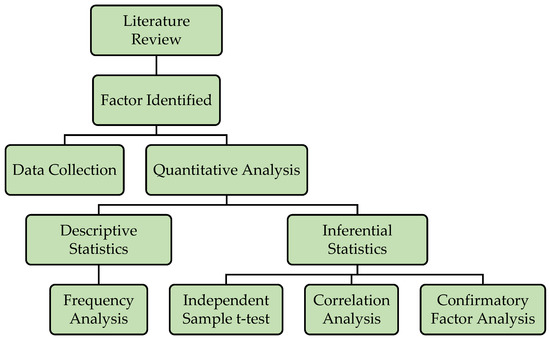
Figure 2.
Methodology flow chart.
The questionnaire was designed based on the factors identified in the literature and expert interviews. Respondents were requested to rate the items on a five-point Likert scale ranging from 1 (strongly disagree) to 5 (strongly agree). Stress, personal satisfaction, work culture, and top-level acceptance were measured using a 25-item instrument. Respondents were requested to rate the items on a five-point Likert scale ranging from 1 (not at all) to 5 (almost all the time). The WLB was measured using a two-item instrument with a five-point Likert scale ranging from 1 (low) to 5 (very high). A total of 360 construction industry professionals, located in Chennai and Ernakulum in South India, were invited to participate in the survey. A total of 200 people completed the survey, 50% each from Chennai and Ernakulum. All the participants worked in reputable construction companies.
2.2. Data Analysis
Data analysis was performed using the SPSS version 23.0 software (Statistical Package for Social Sciences). Following the review of the literature, the study identified that seven factors (work environment, family, stress, personal satisfaction, work culture, top-level acceptance, and work–family balance) were essential for a detailed and practical study of the WFI among construction workers. The mean standard deviation and shape measures (skewness and kurtosis) were found. The result shows that personal satisfaction (3.55) was rated as the top factor for the WFI of employees in the construction industry, followed by work–family balance (3.15), stress (2.91), and work culture (2.83).
3. Results and Discussion
3.1. Frequency Analysis
The respondents were asked to provide their demographic details, such as sex, age, marital status, number of children, and years of experience. The total working hours per day, and whether they stayed with their family or needed to work night shifts, were also recorded. A total of 78% of the professionals stayed with their family, while 22% lived alone, having left their families in their hometowns. Table 1 shows the demographic characteristics.

Table 1.
Demographic profile of the respondents.
The measure of data reliability was measured using the coefficient of reliability under Cronbach’s alpha. From the analysis of all elements, the Cronbach’s alpha scores were found to be 0.786, which were higher than the limit score of 0.7. Henceforth, it can be concluded that the design of the survey instrument for the current work is consistent.
3.2. Independent Sample t-Test
Three hypotheses, with their corresponding null hypotheses, were tested using independent sample t-tests:
H1.
There is no specified difference with respect to the perception of employees based on the location towards the WFI factors in the construction industry.
H2.
There is no specified difference with respect to the employees’ perception of gender towards the WFI factors in the construction industry.
H3.
There is no specified difference with respect to the employees’ perception of marital status towards the WFI factors in the construction industry.
3.2.1. Hypothesis 1
From the results in Figure 3, it was made clear that the male and female respondents of the study differed significantly with respect to the mean rating for the factors work environment (t = 0.003, and p = 0.000), stress (t = 3.062, and p = 0.003), top-level acceptance (t = 3.035, and p = 0.003), and work–family balance (t = 1.981, and p = 0.049). However, the present study did not identify any significant differences in the mean score between employees working in Chennai and Ernakulum for factors, such as family, personal satisfaction, and work culture. Therefore, H1 is supported for the factors family, personal satisfaction, and work culture, but rejected for the factors work environment (1% level), stress (1% level), top-level acceptance (1% level), and work–family balance (5% level). Family, personal satisfaction, and work culture play a vital role in the WFI, even when tested based on two different locations. The analysis shows that personal satisfaction is an essential factor, which can be related to the theory of needs [36]. The highest level of needs according to this theory is self-esteem, which is equivalent to personal satisfaction. Next came work culture, which can be understood through the doctrines of organizational culture; every organization possesses its own culture, which should be aligned to its own people’s culture. Another critical factor is the family, which is the basic element of any social set-up, and any behavioural shortcomings will have both direct and indirect effects on the family.
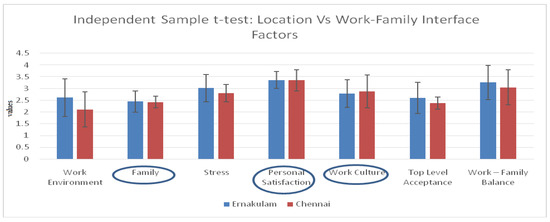
Figure 3.
Independent sample t-test: location vs. work–family interface factors.
3.2.2. Hypothesis 2
H2 was tested using independent sample t-tests with gender as the independent variable and the WFI factors as the dependent variables. Figure 4 showed that male and female respondents differed significantly in the mean rating for the factors work environment (t = 2.0978, and p = 0.032), family (t = 2.6681, and p = 0.008), stress (t = 2.23, and p = 0.023), personal satisfaction (t = 2.654, and p = 0.008), and top-level acceptance (t = 2.671, and p = 0.007). However, the present work has not identified any significant differences in the mean rating of male and female employees for the factors work culture and work–family balance. Therefore, H2 is accepted for the factors work culture and work–family balance but rejected for the factors work environment (5% level), family (1% level), stress (5% level), personal satisfaction (1% level), and top-level acceptance (1% level). Work culture and WLB play a critical role in both genders. During the study, it is also seen that some organisational work culture helps employees to spend more time with family. However, at certain times, professional life is affected by family commitments and concerns.
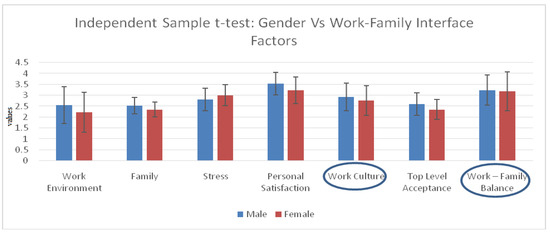
Figure 4.
Independent sample t-test: gender vs. work–family interface factors.
3.2.3. Hypothesis 3
In Figure 5, it was clarified that the single and married respondents in the study differed significantly in the mean rating of factors, such as work environment (t = 2.635, and p = 0.010), family (t = 2.045, and p = 0.042), stress (t = 3.914, and p = 0.000), top-level acceptance (t = 2.7145, and p = 0.007), and balance (t = 3.281, and p = 0.001). However, the current study has failed to identify any significant change in the mean rating between single and married respondents for personal satisfaction and work culture. Therefore, H3 is accepted for the factors personal satisfaction and work culture but rejected for the factors work environment (5% level), family (5% level), stress (5% level), top-level acceptance (1% level), and work–family balance (1% level). Personal satisfaction does not play an important role in marital status, but the level of stress will be greater in the work culture of married people.
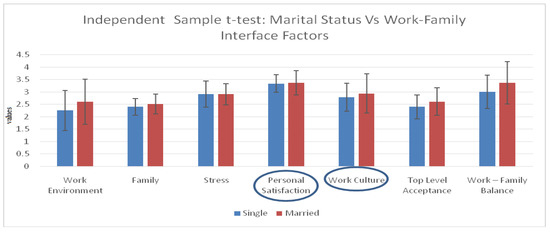
Figure 5.
Independent sample t-test: marital status vs. work–family interface factors.
3.3. Correlation Analysis
A correlation analysis was conducted to find if there are any relationships between the factors governing the WFI of employees in the construction industry. In Table 2, stress was positively correlated with the work environment of construction management professionals (R = 0.143) at the 5% significance level. The relationship between top-level acceptance and work environment was also significant (R = 0.177) at the 5% significance level. Similarly, the work–family balance was positively correlated with the work environment (R = 0.708) at the 1% significance level. This implies that construction management professionals’ productivity and performance could be negatively impacted if adequate WFI is not maintained. This finding has great implications for construction management leaders and chief executives, and they should formulate measures to make the working environment more conducive for their employees, including those working at the managerial and operational levels.

Table 2.
Correlation coefficient matrix between the factors.
Finally, the work–family balance was positively correlated with work culture (R = 0.181) at the 5% significance level. This study found that the work culture was not significantly correlated with the work environment, family, stress, personal satisfaction, or top-level acceptance.
3.4. Confirmatory Factor Analysis Using Structural Equation Modelling
Structural Equation Modelling (SEM) has been used based on the theoretical model developed in the present work. Figure 6 and Figure 7 represent the unstandardised and standardised evaluations of the dimension model formulated in the present study. This study found that work environment and work–family balance had a significant impact on the WFI of construction professionals. The fit for goodness representing a statistical model defines the ways the model fits into the selected set of explanations. Table 3 predicts the results of the fit for goodness indices of the SPSS analysis of moment structures (AMOS) model developed for the study. The I-value was 0.172, which is higher than the suggested value of 0.05. The attained values of the goodness of fit index (GFI) and the adjusted Goodness of fit index (AGFI) were higher than the recommended value of 0.9 [37]. Similarly, the obtained value for the comparative fit index (CFI) was 0.969, above the threshold value of 0.9 [38]. The root mean square error of approximation (RMSEA) value was 0.042, which is relatively less than the suggested value of 0.09 [39]. Overall, the overall model fit values obtained in the current study are within an acceptable level. Therefore, it was determined that the measurement model was a fit. Table 4 shows the weights of SEM.
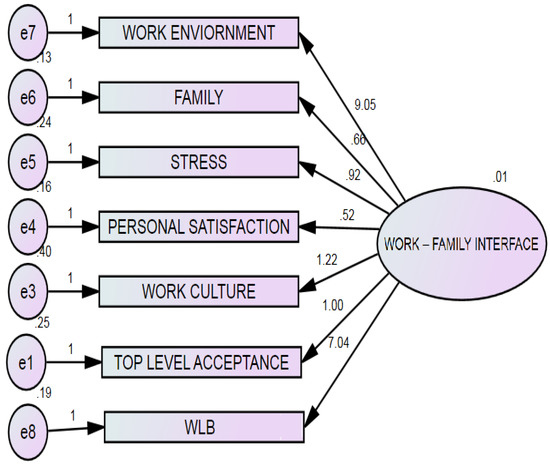
Figure 6.
Unstandardised estimates.
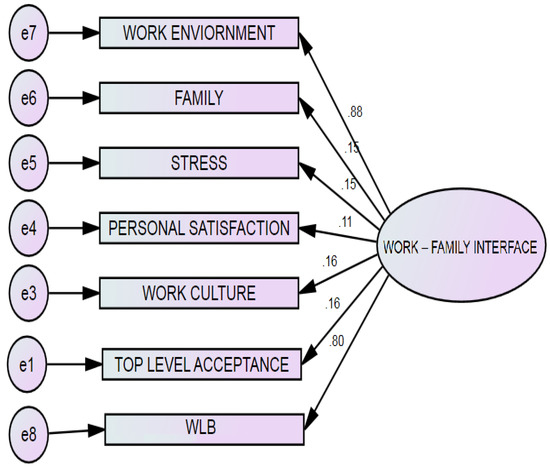
Figure 7.
Standardised estimates.

Table 3.
The goodness of fit: AMOS model.

Table 4.
Regression weights of the structural equation model.
4. Conclusions
This study found that family and personal satisfaction were the most prominent factors that play a vital role in the WFI with respect to location. At the same time, work culture and work–family balance were the dominant factors influencing the WFI in female and male construction professionals. However, this study also revealed that, for married respondents, personal satisfaction did not play a significant role for the WFI. Furthermore, it was revealed that work culture and a high level of stress were the main factors influencing the WFI among married construction professionals. In the future studies, information on their experience can be collected and the results can be compared. Using correlation analysis, this study found that the work environment, stress, work culture, personal satisfaction, and top-level acceptance played a key role. The model was a good fit, as established through confirmatory factor analysis and revealed that the work environment and work–family balance had a significant impact on the WFI. The SEM model developed emphasises the need to pay great attention to the work environment and the balance between work and family among construction professionals in India. In light of these findings, it can be concluded that construction organisations should consider the physical and overall mental health well-being of their employees and not focus only on the delivery of key project performance indicators, such as cost, time, quality, safety, and sustainability. Although this study was limited to South India, the findings could be applied to other parts of India and could direct future studies on WFI in other parts of the world. This study suggests that the prominent factors identified should be considered by management to design standard policies to improve WFI and to develop WLB strategies to create stability in the lives of construction professionals. In the future, longitudinal studies can be conducted as this study is considered to be cross-sectional. Additionally, with the help of a large sample, survey can be conducted and a qualitative method can be adopted for the in-depth exploration of the mindset of the construction professionals, since it differs for each country and context.
Author Contributions
Conceptualization, K.S.A. and M.G.S.P.; methodology, K.S.A.; software, E.I.D.; validation, K.S.A., K.P. and K.G.; formal analysis, M.G.S.P.; investigation, M.G.S.P.; resources, M.G.S.P. and D.S.; data curation, M.G.S.P. and D.S.; writing—original draft preparation, M.G.S.P.; writing—review and editing, K.S.A., M.S. and E.I.D.; visualization, M.S. and E.I.D.; supervision, K.S.A., K.P. and K.G.; project administration, K.S.A., M.S. and E.I.D. All authors have read and agreed to the published version of the manuscript.
Funding
This research received no external funding.
Data Availability Statement
The data presented in this study are available on request from the corresponding author. The data are not publicly available because some data are proprietary or confidential. Therefore, the data may only be provided with restrictions (e.g., anonymized data).
Conflicts of Interest
The authors declare no conflict of interest.
References
- Indian Construction Industry: Indian Construction Industry Overview. Available online: https://www.indianconstructionindustry.com/overview.html (accessed on 11 October 2021).
- Lingard, H.; Francis, V.; Turner, M. Work-life strategies in the Australian construction industry: Implementation issues in a dynamic project-based work environment. Int. J. Proj. Manag. 2012, 30, 282–295. [Google Scholar] [CrossRef]
- Townsend, K.; Lingard, H.; Bradley, L.; Brown, K.; Lingard, H.; Brown, K. Working time alterations within the Australian construction industry. Pers. Rev. 2012, 40, 70–86. [Google Scholar] [CrossRef]
- Lingard, H.; Francis, V. The decline of the ‘traditional’ family: Work-life benefits as a means of promoting a diverse workforce in the construction industry of Australia. Constr. Manag. Econ. 2005, 23, 1045–1057. [Google Scholar] [CrossRef]
- Malone, E.K.; Issa, R.R.A. Work-life balance and organizational commitment of women in the U.S. construction industry. J. Prof. Issues Eng. Educ. Pract. 2013, 139, 87–98. [Google Scholar] [CrossRef]
- Cattell, K.; Bowen, P.; Edwards, P. Stress among South African construction professionals: A job demand-control-support survey. Constr. Manag. Econ. 2016, 34, 700–723. [Google Scholar] [CrossRef]
- Mustapha, F.H.; Naoum, S. Factors influencing the effectiveness of construction site managers. Int. J. Proj. Manag. 1998, 16, 1–8. [Google Scholar] [CrossRef]
- Parakandi, M.; Behery, M. Sustainable human resources: Examining the status of organizational work-life balance practices in the United Arab Emirates. Renew. Sustain. Energy Rev. 2016, 55, 1370–1379. [Google Scholar] [CrossRef]
- Jepson, J.M.; Kirytopoulos, K.; London, K. Exploring project managers’ perception of stress when working in increasingly complex construction projects. Constr. Econ. Build. 2017, 17, 47–67. [Google Scholar] [CrossRef]
- Anandh, K.S.; Gunasekaran, K.; Senthamizh Sankar, S. An envisage on emotional intelligence among superior-subordinate in construction sector of Chennai City, India. AIP Conf. Proc. 2020, 2277, 240012. [Google Scholar]
- Sawicki, M.; Szóstak, M. Quantitative Assessment of the State of Threat of Working on Construction Scaffolding. Int. J. Environ. Res. Public Health 2020, 17, 5773. [Google Scholar] [CrossRef]
- Sawicki, M.; Szóstak, M. Impact of Alcohol on Occupational Health and Safety in the Construction Industry at Workplaces with Scaffoldings. Appl. Sci. 2020, 10, 6690. [Google Scholar] [CrossRef]
- Kiruthiga, K.; Anandh, K.S.; Gunasekaran, K. Assessment of influencing factors on improving effectiveness and productivity of construction engineers. Int. J. Appl. Eng. Res. 2015, 10, 13849–13854. [Google Scholar]
- Youniss, A.; Ismail, A.B.; Khoiry, M.A. A conceptual model of delay factors affecting road construction projects in Liby. J. Eng. Sci. Technol. 2017, 12, 3286–3289. [Google Scholar]
- Anandh, K.S.; Prasanna, K.; Priya, M.G.; Simon, S.M. An industrial study of just in time (JIT) management in precast construction projects. AIP Conf. Proc. 2020, 2277, 240011. [Google Scholar]
- McCuen, R.H. Balancing corporate and personal values. J. Manag. Eng. 1998, 14, 40–44. [Google Scholar] [CrossRef]
- Lingard, H.; Francis, V. Managing Work-Life Balances in Construction; Spon Press: London, UK; Routledge: London, UK, 2009. [Google Scholar]
- Minarelli, J.; Baroudi, B. The Work-Life Balance of Construction Management Professionals. In Proceedings of the Construction, Building and Real Estate Research Conference of the Royal Institution of Chartered Surveyors, Toronto, ON, Canada, 19–22 September 2016; pp. 1–11. [Google Scholar]
- Martínez-León, I.M.; Olmedo-Cifuentes, I.; Ramón-Llorens, M.C. Work, personal and cultural factors in engineers’ management of their career satisfaction. J. Eng. Technol. Manag. 2018, 47, 22–36. [Google Scholar] [CrossRef]
- Greenhaus, J.H.; Collins, K.M.; Shaw, J.D. The relation between work—Family balance and quality of life. J. Vocat. Behav. 2003, 63, 510–531. [Google Scholar] [CrossRef]
- Sommerville, J.; Langford, V. Multivariate influences on the people side of projects: Stress and conflict. Int. J. Proj. Manag. 1994, 12, 234–243. [Google Scholar] [CrossRef]
- Behson, S.J. The relative contribution of formal and informal organizational work-family support. J. Vocat. Behav. 2005, 66, 487–500. [Google Scholar] [CrossRef]
- Cattell, K.S.; Bowen, P.A.; Cooper, C.L.; Edwards, P.J. The State of Well-Being in the Construction Industry; The Chartered Institute of Building: Bracknell, UK, 2017. [Google Scholar]
- Hofstede, G. Dimensional zing Cultures: The Hofstede Model in Context. Online Read. Psychol. Cult. 2009, 2, 8. [Google Scholar]
- Lingard, H.; Francis, V. The work-life experiences of office and site-based employees in the Australian construction industry. Constr. Manag. Econ. 2004, 22, 991–1002. [Google Scholar] [CrossRef]
- Butler, A.B.; Grzywacz, J.G.; Bass, B.L.; Linney, K.D. Extending the demands-control model: A daily diary study of job characteristics, work-family conflict and work-family facilitation. J. Occup. Organ. Psychol. 2005, 78, 155–169. [Google Scholar] [CrossRef]
- Francis, V.; Lingard, H.; Prosser, A.; Turner, M. Work-family and construction: Public and private sector differences. J. Manag. Eng. 2013, 29, 392–399. [Google Scholar] [CrossRef]
- Krane, P.H.; Olsson, N.O.E. Uncertainty management of projects from the owners’ perspective, with main focus on managing delivered functionality. Int. J. Manag. Proj. Bus. 2014, 7, 133–143. [Google Scholar] [CrossRef]
- Lingard, H.; Francis, V. Does a supportive work environment moderate the relationship between work-family conflict and burnout among construction professionals? Constr. Manag. Econ. 2006, 24, 185–196. [Google Scholar] [CrossRef]
- Anandh, K.S.; Gunasekaran, K.; Sunny, D. A review on the work-family interface of construction professionals in south India. J. Adv. Res. Dyn. Control Syst. 2018, 10, 405–420. [Google Scholar]
- Anandh, K.S.; Gunasekaran, K. An investigation on stress among the professionals in the Indian construction industry. In Proceedings of the Construction Research Congress, ASCE, New Orleans, LA, USA, 2–4 April 2018; pp. 1–7. [Google Scholar]
- Rani, H.A.; Radzi, A.R.; Alias, A.R.; Almutairi, S.; Rahman, R.A. Factors affecting workplace well-being: Building construction projects. Buildings 2022, 12, 910. [Google Scholar] [CrossRef]
- Anandh, K.S.; Gunasekaran, K. Constructing a model to examine the influence of quality of work-life on work-life balance—Discernment of civil engineers from construction industry in Chennai. Indian J. Sci. Technol. 2016, 9, 1–12. [Google Scholar] [CrossRef]
- Soundarya Priya, M.G.; Anandh, K.S.; Kamal, S.; Shanmuga Priya, S. Assessing Quality of Working Life (QWL) Among Construction Professionals in Private Sectors in Chennai. Lect. Notes Civ. Eng. 2022, 284, 635–647. [Google Scholar]
- Zhang, R.P.; Bowen, P. Work-family conflict (WFC)—Examining a model of the work-family interface of construction professionals. Saf. Sci. 2021, 144, 105469. [Google Scholar] [CrossRef]
- McLeod, S. Maslow’s hierarchy of needs. Simply Psychol. 2007, 1, 1–18. [Google Scholar]
- Hooper, D.; Coughlan, J.; Mullen, M. Structural equation modelling: Guidelines for determining model fit. Electron. J. Bus. Res. Methods 2008, 6, 53–60. [Google Scholar]
- Hu, L.T.; Bentler, P.M. Cut off criteria for fit indexes in covariance structure analysis: Conventional criteria versus new alternatives. Struct. Equ. Model. 1999, 6, 1–55. [Google Scholar] [CrossRef]
- Hair, J.F. Multivariate Data Analysis, 7th ed.; Prentice-Hall: Upper Saddle River, NJ, USA, 2010. [Google Scholar]
Disclaimer/Publisher’s Note: The statements, opinions and data contained in all publications are solely those of the individual author(s) and contributor(s) and not of MDPI and/or the editor(s). MDPI and/or the editor(s) disclaim responsibility for any injury to people or property resulting from any ideas, methods, instructions or products referred to in the content. |
© 2023 by the authors. Licensee MDPI, Basel, Switzerland. This article is an open access article distributed under the terms and conditions of the Creative Commons Attribution (CC BY) license (https://creativecommons.org/licenses/by/4.0/).